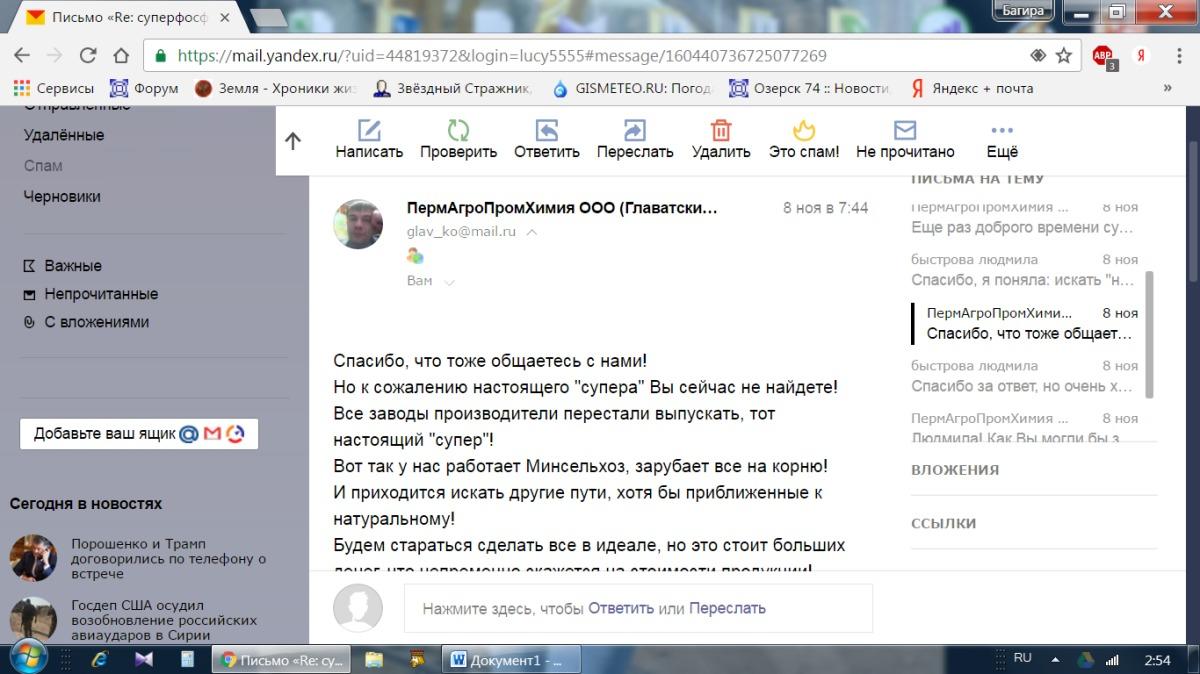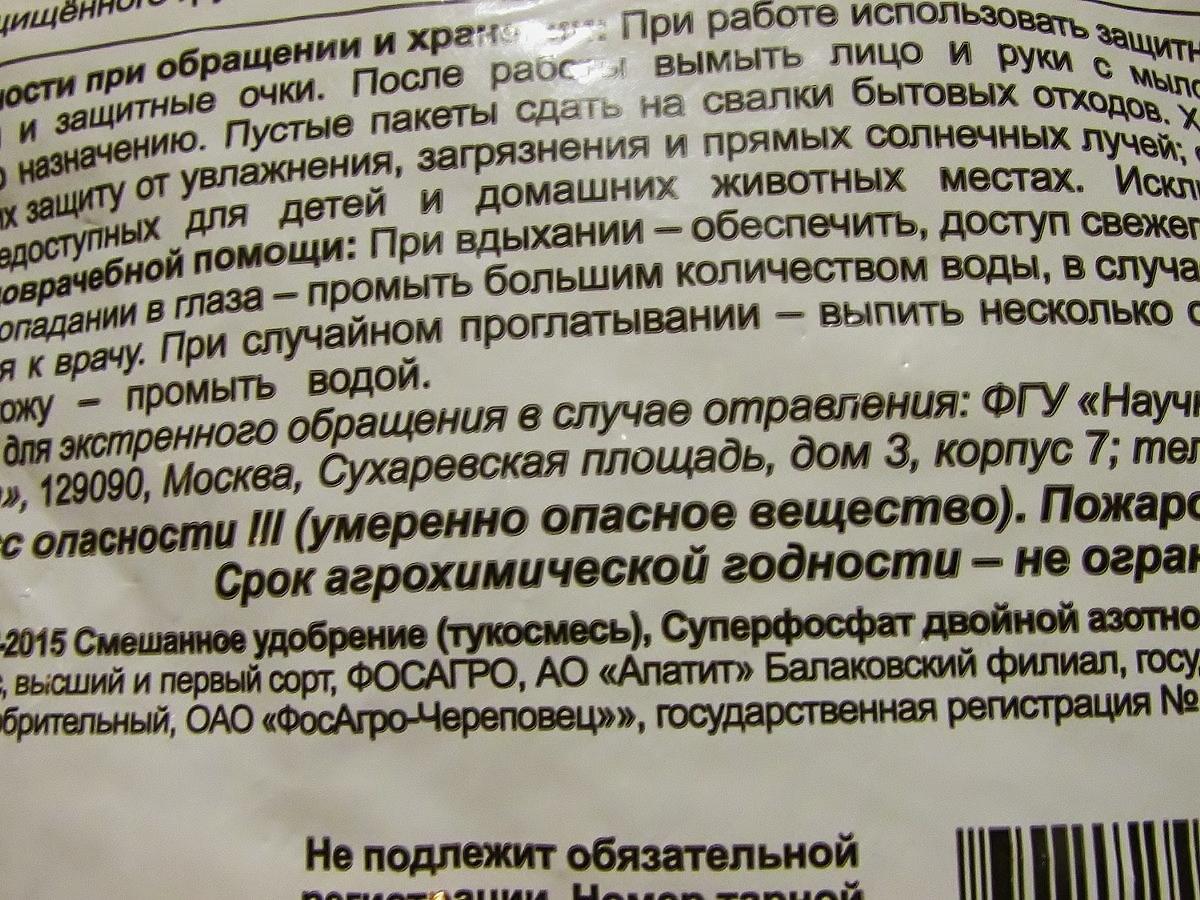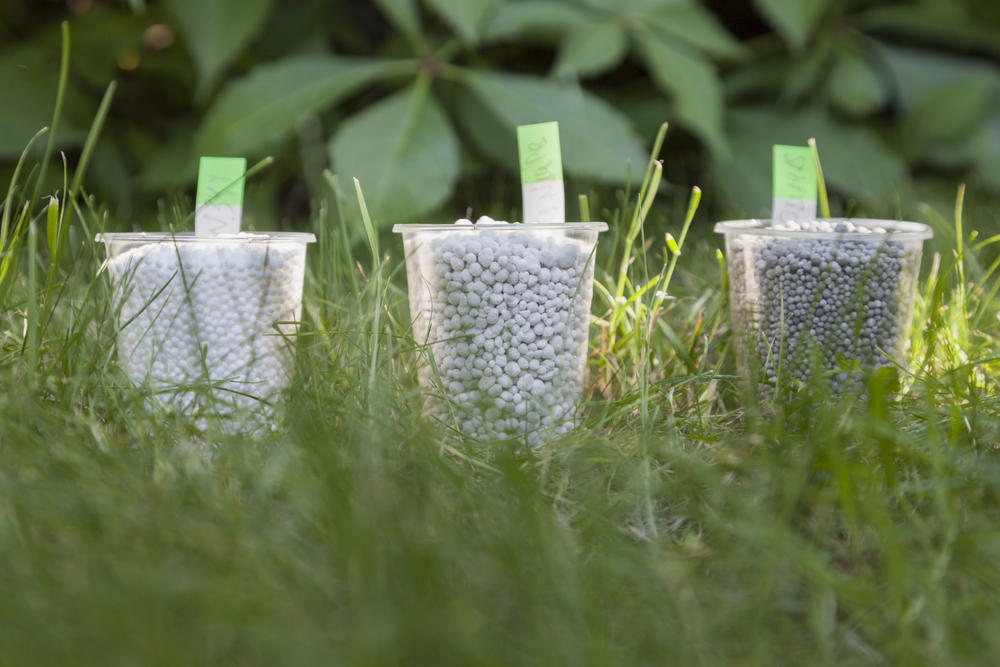Simple granular superphosphate. Fertilizer simple superphosphate - composition and formula
I'll start by saying honestly: I am a supporter of chemical-free farming. It's just that I'm a chemist by education, and often I understand the world directly in the form of formulas. Sometimes it gets in the way of living. Sometimes, and much more often, it helps to live.
Parents at one time brought so many cars to a plot of 5 acres in SNT, located in a forest, that one can say: I have good land. Later there were several different packages. Including double superphosphate, which I used when planting seedlings and, and scattered the last remnants under them this fall.
In the end, my choice fell on "Permagropromkhimiya", especially since the Perm fertilizers in the stores of our city are the majority.

According to the specified email address I just took it, and I wrote to the plant that I was looking for a double superphosphate for the garden. Let's leave outside the scope of the article comments on the first answer of the plant, in which I was asked: "And who told you that nitrogen should not be brought in in the fall?"
Then I wrote the above formulas for obtaining with the question, where did the nitrogen come from. And if it is added additionally, why is there no inscription "mixture" on the pack? I quote the answer verbatim, with all the exclamation marks:

It turns out that there is no real ...
Unfortunately, you will not find a real "super" now! All factories stopped producing the real "super" one! This is how the Ministry of Agriculture works for us, cuts everything down in the bud! And you have to look for other ways, at least close to natural! .. But if you carefully examine the packaging, you will have to notice just above the barcode on the reverse side that it is a mixed fertilizer (fertilizer mixture) and, accordingly, its ingredients.
As a side note: There is professional slang in many professions. In this case, the term "double superphosphate" has been replaced by the term "super" for brevity. And there is nothing superb in this case ...
We will see:

We read the decoding of the term fertilizer mixture in the "Big Encyclopedia of Oil and Gas": "Fertilizing fertilizer mixture (for fruit and berry, vegetable and flower crops) is a grayish-white powder. Obtained by mixing ammonium sulfate, ammophos and sulfate and potassium chloride. Designed for retail»
Modern dictionary Russian language Efremova reports the following: "Fertilizer mixture is a mechanical mixture of mineral fertilizers with fat" And additionally from the same source: "Fat - humus, manure, mineral fertilizers"That is, in any case, the term "Fat" means there will be nitrogen in the mixture!

There is GOST 16306-80 “Double granular superphosphate. Technical conditions ", and nobody canceled this GOST, it has a stamp" valid ". I'll tell you a secret: GOST does not provide for nitrogen either. But if you look at your packs with, you will see links to different specifications ( technical conditions). They arrived, called.
It's like we ate something containing palm oil according to TU, instead of cheese or cottage cheese according to GOST. But after 20 years of deception, food manufacturers were forced to write a “cheese” or “curd” product and not mislead the consumer. Will there come a day when producers will be forced to write "fertilizer mix" on the front side and not at the bottom in small letters next to the barcode?
And I just have to ask you to carefully read the composition of the fertilizer that you buy, and not to believe the huge inscription "DOUBLE SUPERPHOSPHATE", assuming that it is pure. And for looking for the smallest of evils, that is, the one in which there is a minimum amount of nitrogen.

After my research, I concluded that I do not like modern trend to produce fertilizers with the names "for roses", "for potatoes", "for tomatoes" and the like, because they have absolutely no information about what this mixture is made of. And I want to know which substances were mixed in a particular case.
The search is over.
Afterword
Oh yes, there is still something to wait. I wrote a question about factories producing "real double superphosphate" to the Ministry Agriculture Russian Federation... But the Ministry of Agriculture is not a sales manager of the plant, the Ministry of Agriculture has the right to respond within 30 days. I will wait, and if I get an answer, I will definitely publish it in the comments to the article.And I ask you again: carefully study the composition of everything that you buy. This is very important in any case: although you need fertilizer for autumn feeding garden, even a kitchen cleaner.
The article is posted in sections:,
All phosphate fertilizers are amorphous substances, whitish-gray or yellowish in color. The main ones are superphosphates. Phosphate rock is finely ground natural phosphorite, the compounds of which are difficult for plants to access. This fertilizer is used on acidic podzolic, peat, gray forest soils, as well as on degraded and leached chernozems and red soils.
Phosphate fertilizers are the only source of replenishment of phosphorus reserves in the soil. Phosphate fertilizers increase the yield and improve its quality, accelerate the ripening of plants, increase their resistance to lodging and drought.
Industrial production of phosphate fertilizers is based on the processing of minerals - apatite and phosphorite. The content of P 2 O 5 in phosphorus ore varies from 5 to 35%, so they are subject to beneficiation. During the processing of phosphorus raw materials, phosphorus is converted into a form assimilable for plants.
Phosphate fertilizers differ among themselves not only in percentage composition, but also in the degree of solubility. According to the degree of solubility, phosphoric ones are divided into 3 groups:
... Containing phosphorus in a water-soluble form, readily available for plants - simple and double superphosphates, ammoniated, enriched;
... Containing phosphorus, insoluble in water, but soluble in weak acids; cannot be used directly by plants - phosphate rock and bone meal;
... Containing phosphorus in the form of compounds insoluble in water and weak acids,
which, under the influence of soil acidity and root secretions of plants, gradually passes into a form assimilable by plants.
Currently, the production volumes of pure phosphorus fertilizers (superphosphate, double superphosphate, etc.) in Russia and in the world are insignificant. Phosphorus itself, as nutrient, is included mainly in complex mineral fertilizers, in the production of which nitrogen and potassium are also used. On the territory of Russia, the main types of phosphorus fertilizers produced are ammophos, diammophos and azophoska (NPK). Complex phosphorus-containing fertilizers will be discussed in a separate section of this chapter, but now we will take a closer look at simple phosphorus fertilizers.
Properties of simple mineral phosphorus fertilizers
| Fertilizers | Chemical formula | ContentP 2 O 5 |
| Superphosphate simple granular | Ca (H 2 PO 4) 2 ∙ H 2 O + 2Ca SO 4 | 14-19.5 |
| Superphosphate double granular | Ca (H 2 PO 4) 2 ∙ H 2 O | 45 |
| Phosphorite flour | CaF (PO 4) 3 + CaOH (PO 4) 3 + Ca CO 3 | 19-30 |
Simple superphosphate - Ca (H 2 PO 4) 2. Contains 16-20% Р 2 О 5. This basic phosphoric fertilizer is obtained by treating finely ground apatite or phosphorite with sulfuric acid. Almost all the phosphoric acid found in superphosphate dissolves in water and is well absorbed by plants. The fertilizer contains about 6% nitrogen, 10% sulfur, 17% calcium, 0.5% magnesium. Powdered and granular superphosphate is available. Granular superphosphate has a number of advantages over powdery one: it usually contains more phosphorus (up to 26%), does not form lumps and does not cake, it can be applied to the soil using grain seed drills.
During the granulation process, the free phosphoric acid is neutralized and the superphosphate is dried, so the amount of free phosphoric acid it decreases to 1-2.5%, and moisture - to 1-4%. Phosphorus of granular superphosphate is less fixed by the soil-absorbing complex, which is especially important for acidic soils containing increased amounts of iron and aluminum, since phosphorus forms insoluble compounds with these elements.
Superphosphate double - Ca (H 2 PO 4) 2. It differs from simple superphosphate in increased phosphorus concentration - up to 45% and above. It is the most widespread phosphate fertilizer, both in the CIS countries and abroad.
Precipitate - CaNRO 4 × H 2 O - contains up to 35% P 2 O 5. White or light gray, non-caking powder, disperses well when applied to the soil. The phosphorus of the precipitate dissolves in ammonium citrate and is readily available to plants. In its effect on the yield of plants, it is close to superphosphate, but it is suitable only for the main introduction for plowing. On acidic soils and gray soils, precipitate is even more effective than superphosphate. On chernozems, these two fertilizers are equivalent, or the effect of superphosphate is slightly higher than that of precipitate.
Phosphorite flour - mineral phosphorus fertilizer obtained by fine grinding of phosphorites - sedimentary rocks formed mainly by minerals of the apatite group. Contains 19-30% P 2 O 5 as Ca 3 (PO 4) 2. Since calcium phosphate is poorly soluble in water, phosphorite flour can be absorbed by plants only on acidic soils - podzolic and peat - in which Ca 3 (PO 4) 2 gradually transforms into the hydrophosphate Ca (H 2 PO 4) 2 .H 2 O available to plants. The assimilation of phosphorite flour is favored by the fineness of grinding, as well as its introduction into the soil together with acidic fertilizers, for example, with (NH 4) 2SO 4 or manure. It is also used for the preparation of manure and peat composts. The main advantage of phosphate rock as a fertilizer is its low cost; environmental harmlessness and long-term aftereffect can also be noted.
Below are the specifications basic simple phosphate fertilizers.
Physicochemical characteristics of simple granular superphosphate
The name of indicators | Norm for the brand | ||
| BUT | B | IN | |
| Appearance | |||
| not less than 21 | 26+/-1 | not less than 22 | |
| no more than 1.5 | no more than 1, 5 | no more than 1.5 | |
| not less than 5 | |||
| Mass fraction of N,% | not less than 3 | 6+/-1 | not less than 3 |
| 2 | 2 | 2 | |
| S),% | 7-10 | 8-10 | 8-10 |
| 11-14 | 12-17 | 12-17 | |
| less than 1 mm,% no more | 4 | 4 | 5 |
| from 1 to 4 mm,% not less | 85 | 85 | 80 |
| less than 6 mm,% | 100 | 100 | 100 |
| 3(30) | 3(30) | 3(30) | |
| Looseness,% | 100 | 100 | 100 |
| lead (Pb) | 0,002 | 0,002 | 0,002 |
| cadmium (Cd) | 0,0001 | 0,0001 | 0,0001 |
| mercury (Hg) | 0,00002 | 0,00002 | 0,00002 |
| arsenic (As) | 0,0004 | 0,0004 | 0,0004 |
| nickel (Ni) | 0,002 | 0,002 | 0,002 |
| strontium (Sr) | 0,5 | 0,5 | 0,5 |
| chromium (Cr total) | 0,003 | 0,003 | 0,003 |
Physicochemical characteristics of double granular superphosphate
The name of indicators | Norm for the brand | ||
| BUT | B | IN | |
| Appearance | Granular product without foreign mechanical impurities | ||
| Mass fraction of assimilated phosphates in terms of P2O5,% | not less than 21 | 26+/-1 | not less than 22 |
| Mass fraction of free acid in terms of Н3РО4,% | no more than 1.5 | no more than 1, 5 | no more than 1.5 |
| Mass fraction of potassium in terms of K2O,% | not less than 5 | ||
| Mass fraction of N,% | not less than 3 | 6+/-1 | not less than 3 |
| Mass fraction of water,%, no more | 2 | 2 | 2 |
| Mass fraction of sulfates in terms of sulfur ( S),% | 7-10 | 8-10 | 8-10 |
| Mass fraction of calcium in terms of CaO,% | 11-14 | 12-17 | 12-17 |
| Grading, mass fraction granule size: | |||
| less than 1 mm,% no more | 4 | 4 | 5 |
| from 1 to 4 mm,% not less | 85 | 85 | 80 |
| less than 6 mm,% | 100 | 100 | 100 |
| Static strength of granules, MPa (kgf / cm2), not less | 3(30) | 3(30) | 3(30) |
| Looseness,% | 100 | 100 | 100 |
| Mass fraction of heavy metals and toxic compounds,%, no more | |||
| lead (Pb) | 0,002 | 0,002 | 0,002 |
| cadmium (Cd) | 0,0001 | 0,0001 | 0,0001 |
| mercury (Hg) | 0,00002 | 0,00002 | 0,00002 |
| arsenic (As) | 0,0004 | 0,0004 | 0,0004 |
| nickel (Ni) | 0,002 | 0,002 | 0,002 |
| strontium (Sr) | 0,5 | 0,5 | 0,5 |
| chromium (Cr total) | 0,003 | 0,003 | 0,003 |
Simple superphosphate is a fast-acting phosphorus mineral fertilizer.
Release form
Granular product or free-flowing powder, light gray (shades from white to dark gray are possible). Fully soluble in water.
Compound
Simple superphosphate contains phosphorus, which is present in the form of free phosphoric acid and calcium phosphate. Small amounts of gypsum are contained, as well as other impurities (aluminum and iron phosphates, fluorine compounds, silica).
Simple superphosphate ( chemical formula(CaH2PO4) 2 x H2O + 2CaSO4 x 2H2O) - is obtained from phosphorite substances as a result of the use of H 2 SO 4. ...

Application
An effective product for a variety of agricultural crops, can be used on any type of soil as an independent top dressing, and in combination with other mineral fertilizers.
The efficiency of this top dressing is increased by reducing the chemical consumption of phosphoric acid by the soil; for this, granular forms of fertilizer, row or local application are used.
And a little about secrets ...
Have you ever experienced unbearable joint pain? And you know firsthand what it is:
- inability to move easily and comfortably;
- discomfort when going up and down stairs;
- unpleasant crunch, clicking not on on their own;
- pain during or after exercise;
- joint inflammation and swelling;
- unreasonable and sometimes unbearable aching pain in the joints ...
Now answer the question: does this suit you? How can you endure such pain? And how much money have you already "poured" on ineffective treatment? That's right - it's time to end it! Do you agree? That is why we decided to publish an exclusive interview with professor Dikul, in which he revealed the secrets of getting rid of joint pain, arthritis and arthrosis.


